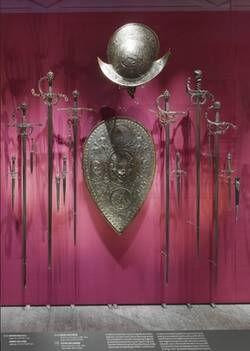The rapiers and daggers in this display case are from the late sixteenth and early seventeenth century. They have carved and blackened iron guards with fully modelled figures and ornamentation. Bodies and heavy chain garlands were not simply laid onto the hilt or the guard, but form the hilt itself, the cross-guard or the bale. The fact that cutlers developed these techniques of iron-carving, etching and metal inlay was partly a result of the guilds‘ restrictive regulations. Cutlers were not allowed to use goldsmith’s techniques, which meant that the makers of rapiers and daggers were generally not permitted to work with precious metals.
A moustachioed warrior decorates one of the main items displayed here: No. 7. His helmet and leather breastplate identify him as a Roman soldier. The blade is Spanish but – judging from the style and technique of the metalwork – we see that the decoration is probably German. Calm and fearless, the warrior gazes out from under his helmet. He appears to be an experienced soldier, not easily ruffled. His muscle armour and skirt and the foliage are rendered in fine detail. We can even see the individual hairs of his moustache.
These splendid items reflect the aesthetic tastes of the period and the great skill of its craftsmen. The attention to detail is particularly striking, and so is the way that one idea leads to another; for instance, how the form in a guard cast as a chain is repeated in manifold variations. The master craftsmen were constantly on the lookout for more sophisticated ways of demonstrating their skills.
The set No. 3 comprises a rapier and a dagger, and is Italian. The rapier blade is marked with a cross and the letter M with a crown above it, the sign for Milan. It was made in the workshop of the master craftsman Vincenzo Figino. A carved iron chain with the ends plaited into knots seems to flow magically into the form of a guard. When it was in use, it must have looked as if the metal were moulded around the owner’s hand. Iron carving flourished in the sixteenth and seventeenth centuries. Not only the hilts of swords, rapiers and daggers, but also locks, plates and individual sections of armour were decorated using this technique.
